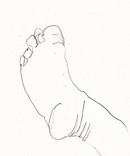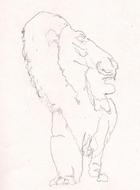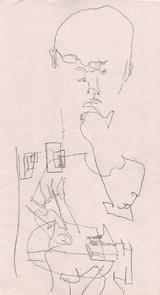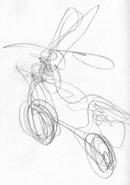A few months ago I posted a series of entries about my passage from stick-figure artist to wide-eyed beginner. I'd like to tell you a bit more about my artistic education and its psychological and emotional implications. The first two exercises that I practiced were called gesture drawing and contour drawing, both of which demanded that I look away from the paper in which I was drawing, keeping my eyes “locked” onto the object I was drawing and let feeling alone, not vision, guide my hand's path on the paper. After I got the hang of not looking at the paper as I drew, I started mixing looking and not looking.
I practiced the exercises in a number of different settings, some public, some private. Every night I'd do a drawing on a sketchbook dedicated to my night person, preparing myself to sleep, to dream, to shift my energies from the quotidian to the spectral (that means, from the sometimes petty preoccupations of daily life to the more fluid energies of the subconscious...).

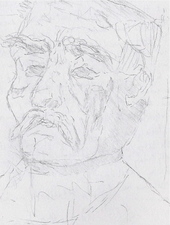
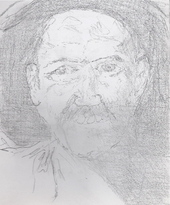 On that sketchbook I started copying faces from the art books I had lying around the house. My wife studied art in college, and over the years she collected a series of books, some about art history, others about aspects of craft, others still purveys of great masters. As an art lover I too had bought a few art books. And you know what? I had never properly read the majority of art books in our modest library. To some degree the books made me feel bad about myself: bad for buying too many books, buying expensive books, buying books that I didn't read... I finally started reading the books, looking closely at some of the images, then reproducing a few. A bonus side-effect to my art education: my library doesn’t make me feel bad anymore!
On that sketchbook I started copying faces from the art books I had lying around the house. My wife studied art in college, and over the years she collected a series of books, some about art history, others about aspects of craft, others still purveys of great masters. As an art lover I too had bought a few art books. And you know what? I had never properly read the majority of art books in our modest library. To some degree the books made me feel bad about myself: bad for buying too many books, buying expensive books, buying books that I didn't read... I finally started reading the books, looking closely at some of the images, then reproducing a few. A bonus side-effect to my art education: my library doesn’t make me feel bad anymore!


 I began filling in huge gaps in my knowledge of art history, and of history itself. I read a biography of Rodin. I read Gauguin's notebooks. And I drew faces: from Velasquez, Murillo, Picasso, Rembrandt, Fra Angelico, and a dozen others. The faces taught me a lot. You look closely, really closely, for twenty minutes or thirty minutes, and the face becomes a person; you invent a whole story for that face, and you begin to empathize with someone who has been dead for hundreds of years. A sparkle in someone's eyes, a shade of sadness, a mysterious smile... (Double-clicking the thumbnail images will magnify them and give you a microscopic view of my handiwork. It's kinda neat!)
I began filling in huge gaps in my knowledge of art history, and of history itself. I read a biography of Rodin. I read Gauguin's notebooks. And I drew faces: from Velasquez, Murillo, Picasso, Rembrandt, Fra Angelico, and a dozen others. The faces taught me a lot. You look closely, really closely, for twenty minutes or thirty minutes, and the face becomes a person; you invent a whole story for that face, and you begin to empathize with someone who has been dead for hundreds of years. A sparkle in someone's eyes, a shade of sadness, a mysterious smile... (Double-clicking the thumbnail images will magnify them and give you a microscopic view of my handiwork. It's kinda neat!)
A well-trained artist might find my sketches very basic, perhaps even full of unpardonable flaws. But, hey! A few weeks before I didn't believe I could draw altogether. You can imagine how happy my night person was with my offerings! It felt to me that I had entered a heightened state of creativity and awareness, of risk-taking, of permanent learning and discovery. I highly recommend the process and the state that comes with it. You know what is required? A sheet of paper and a pencil. If you don't have art books lying around the house, a magazine or a newspaper. Don't have those either? Look in the mirror and draw yourself!
Okay, you blog readers out there. Who's going to recognize these images and tell us exactly where they come from? Show us what you know, and we'll reward you with a virtual pat on the back.



